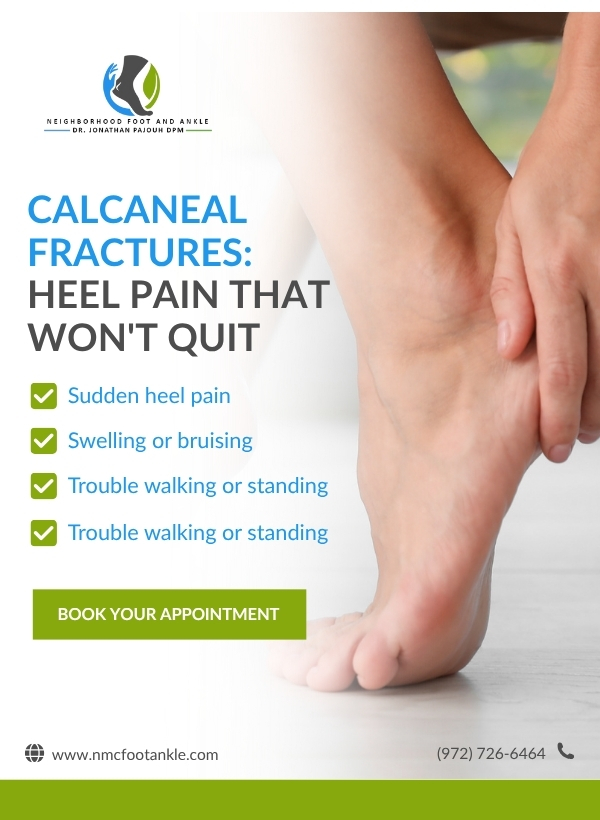Did you know that heel pain affects nearly 1 in 10 adults at some point in their lives? If you find yourself grappling with persistent heel pain, it could signify a more serious condition waiting to be addressed. Understanding the causes and symptoms can significantly impact your treatment journey.
In this blog post, we will explore various types of heel pain, their underlying causes, common symptoms you may experience, and effective treatment options available to help you find relief. Together, we'll unravel the mystery of heel pain and provide you with actionable insights to get you back on your feet!
Understanding Heel Pain
Heel pain is not a single condition but rather a symptom of various underlying issues. The heel, being one of the body’s strongest and largest bones, is subject to numerous stressors. When things go wrong, it can lead to discomfort that disrupts everyday activities.
Common Causes of Heel Pain
1. Plantar Fasciitis:
One of the most common causes of heel pain is plantar fasciitis. This condition is characterized by inflammation of the plantar fascia, a thick band of tissue that runs across the bottom of your foot. Symptoms typically include stabbing pain with the first steps in the morning or after sitting for long periods.
2. Achilles Tendinitis:
Another prominent cause is achilles tendinitis, which occurs when the Achilles tendon at the back of the heel becomes inflamed, often due to overuse or excessive exercise. It's most commonly seen in runners and anyone whose activities put a strain on this tendon.
3. Heel Spurs:
Sometimes, heel pain can be caused by heel spurs—a bony growth on the underside of the heel bone. They can result from prolonged strain on your foot muscles and ligaments or, similarly, from the plantar fascia.
4. Bursitis:
This condition involves inflammation of the bursae, small sacs of fluid that cushion the bones, tendons, and muscles near your joints. When inflamed, they can cause heel pain, particularly during movement.
5. Calcaneal Fractures:
As noted earlier, a calcaneal fracture is a break in the heel bone that can arise from high-impact injuries such as falls, sports accidents, or serious car accidents. Symptoms may include sudden and intense heel pain, swelling, and bruising around the heel area.
Recognizing the Symptoms
Recognizing the symptoms of heel pain is crucial for early diagnosis and treatment. The following signs indicate you may be dealing with a significant issue:
- Sudden heel pain that worsens with activity.
- Swelling or bruising around the heel.
- Tenderness in the heel when touched.
- Pain while standing, walking, or during weight-bearing activities.
It’s essential to observe these symptoms carefully, as they can significantly guide your next steps towards recovery.
Treating Heel Pain
Once you've recognized the symptoms, the next question is, how do you treat it? Here's a comprehensive guide on the treatment options available:
1. Rest and Ice Therapy:
One of the first recommendations is to avoid activities that cause heel pain. Applying ice to the affected area for 15-20 minutes can reduce inflammation and swelling.
2. Physical Therapy:
Engaging a physical therapist can help you strengthen the muscles around your heel and improve flexibility in your foot and ankle. Specific exercises targeting foot mechanics can prevent future injuries.
3. Orthotics and Footwear:
Custom orthotics from Dr. Pajouh can help correct your foot biomechanics and relieve pressure on your heel. Additionally, wearing shoes with adequate cushioning and support can further alleviate discomfort.
4. Medications:
Over-the-counter pain medications, such as ibuprofen or acetaminophen, can provide temporary relief from pain and inflammation, enabling you to engage in your daily activities.
5. Injections:
In some cases, corticosteroid injections can help reduce inflammation and provide significant pain relief.
6. Surgery:
If conservative treatments fail, surgery may be considered. Surgery can involve removing a heel spur or repairing the plantar fascia.
Staying Committed to Recovery
Healing from heel pain often requires patience and effort. It is crucial to follow your doctor's advice, complete prescribed physical therapy sessions, and avoid jumping back into strenuous activities too soon.
What to Do If Your Pain Persists
If your heel pain won’t quit despite your best efforts, don’t waste time—consult Dr. Pajouh at NMC Foot & Ankle Center so he can offer expert insight and treatment options tailored to your needs. The sooner you address ongoing pain, the more likely you will recover fully.
Expert Insights on Maintaining Foot Health
Besides treating existing pain, steps can be taken to promote better foot health in the long term:
1. Maintain a Healthy Weight:
Keeping your weight in check will reduce stress on your feet, especially the heel area.
2. Choose Proper Footwear:
Invest in shoes that offer good arch support and cushioning to help absorb shock and reduce strain on your heels.
3. Stretch Regularly:
Regular stretching of the calf muscles and foot can improve flexibility and strength.
4. Stay Active:
Engaging in low-impact activities like swimming or cycling can help maintain fitness levels while minimizing foot strain.
5. Listen to Your Body:
If you feel pain while engaging in a particular activity, stop and evaluate your approach or seek professional advice.
Closing Thoughts
Heel pain can be debilitating, making routine activities a challenge. By understanding its various causes and how to treat it effectively, you can regain control over your life and stay active. Take proactive steps—whether it's seeing a doctor, engaging in preventive practices, or learning about foot health—to ensure your feet remain pain-free and strong.
Book Your Appointment Online:

